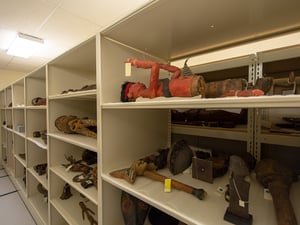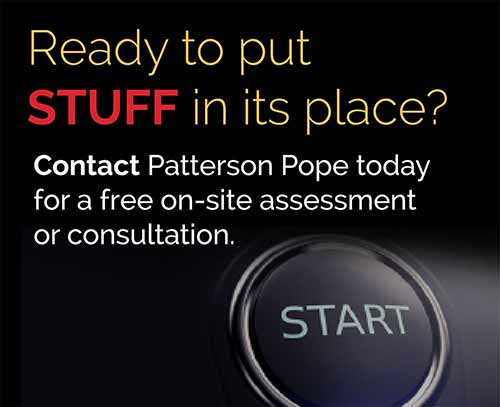P2 Talks – Michael C. Carlos Museum Off-Site Storage Facility
(watch the video below)
New and Old Combine for Innovative Museum Collections Storage
Atlanta’s Emory University understands its position as a vanguard. This is true in many respects: in how it educates its students, how it drives innovation, and in its commitment to fostering advancements in “going green.” In fact, more than 50 percent of the school’s campus has been designated as protected green space. What’s more, Emory pays particular attention to using environmentally conscious construction and advocating for alternative transportation methods. It is, in many respects, a very modern institution.
Most of these actions are, of course, planned. But being environmentally conscious is more than a way of doing things. Being committed to living and working as an environmental steward is a way of being. It’s always on one’s mind – consciously or not. So, when unforeseen opportunities pop up to do good by the earth, it’s all the more rewarding.
For a number of years, Emory’s Todd Lamkin had been planning to renovate and upgrade the shelving at the off-campus storage facility for the university’s renowned Michael C. Carlos Museum. Because the museum itself is in a campus building that was not designed to be a museum, it lacks the storage space to adequately house the sizeable collections onsite. Lamkin is the museum’s director of collections services and chief registrar.
“We have substantial collections of ancient Mediterranean art representing Greece, Rome, Egypt and the Near East,” said Lamkin. “We also have a sub-Saharan African collection, a small Himalayan and Indian/Asian collection, as well as The Art of the Americas, which is primarily Latin, Central and South America. The only collection that is entirely kept at the museum proper is our prints and drawings collection.”
Borrowing from the Library
University budgets being as tight as they are, Lamkin was forced to remain patient for a number of years before approval for the upgrade project was granted. Due to inflation, however, the budget that had been more than adequate several years before now didn’t go as far.
At the same time, Patterson Pope Account Representative Dick Beery became aware that the university’s Woodruff Library was going through a remodel of its own. Like so many university libraries these days, Emory was consolidating its shelving in an effort to create more collaboration and study space for faculty and students.
 “The library was getting rid of a lot of material,” said Beery. “Although it wasn’t exact, the shelving ranges were really close to what Todd wanted for his off-site storage facility. Todd’s new space had been planned using 48″-wide shelving that was 36″ deep. The shelving that was coming out of the Woodruff Library was four-post case-style shelving that measured 36″ wide and 24″ deep. By configuring the 24″-deep shelving back to back, we were able to offer Todd the same dimensional section of shelving of 36″ x 48″. It didn’t matter to Todd that the orientation was different; the cubic space was the same.”
“The library was getting rid of a lot of material,” said Beery. “Although it wasn’t exact, the shelving ranges were really close to what Todd wanted for his off-site storage facility. Todd’s new space had been planned using 48″-wide shelving that was 36″ deep. The shelving that was coming out of the Woodruff Library was four-post case-style shelving that measured 36″ wide and 24″ deep. By configuring the 24″-deep shelving back to back, we were able to offer Todd the same dimensional section of shelving of 36″ x 48″. It didn’t matter to Todd that the orientation was different; the cubic space was the same.”
“We jumped on that opportunity,” added Lamkin. “Financially, it became a much more feasible option to re-use shelving from the library. In doing so, we were able to preserve the overall footprint and design that we had hoped to install in the first place – and we did it within our same budget. It was a real win.”
The new high-density mobile shelving system has a footprint that is approximately 900square feet, which includes four 32′ Mechanical Assist moveable carriages and two stationary ranges with the option of adding two more moveable carriages in the future. Another goal reached was adding eight 96″ x 36″ sections of RaptorRAC Wide-Span Shelving to be used for a wide variety of purposes, such as taking in new collections and temporally storing large objects.
“Like a lot of museums, I’m sure, we have to make the best use of our available square footage,” added Lamkin. “The high-density mobile shelving was really the only option for us in that regard. If we were to store material on fixed shelving alone, we would be occupying two or three times the space, and that’s just not feasible.”

Preserving History While Educating for the Future
To quote the Michael C. Carlos Museum website, the museum “has a distinguished history of providing opportunities for scholars in many disciplines to expand their work and for students to learn by participating in academically rigorous projects.” To be sure, being able to safeguard the myriad objects across several collections is a testament to the university’s passion for advancing knowledge.
 To that end, Lamkin knows that the Michael C. Carlos Museum boasts ambitious curators who want to grow their collections. Very rarely does the museum add a single piece at a time. When collection items are donated – which can number as many as 500 at a time – Lamkin wants to be able to accommodate those donations as best he can. The right storage arrangement helps that happen.
To that end, Lamkin knows that the Michael C. Carlos Museum boasts ambitious curators who want to grow their collections. Very rarely does the museum add a single piece at a time. When collection items are donated – which can number as many as 500 at a time – Lamkin wants to be able to accommodate those donations as best he can. The right storage arrangement helps that happen.
“We very quickly filled up the space that was available in our old open-span shelving,” said Lamkin. “That was an obvious need, and actually, for this new layout, ended up being a substantial portion of the footprint. That was a big need for us, and that material was all new. The reality is that most of our storage is on smaller shelving holding smaller objects. With smaller objects comes greater flexibility in how you place them and store them.”
As for the ability to further commit to Emory’s green initiatives? It was a definite bonus for Lamkin.
“The material was bound for recycling at that point, so getting it was a great opportunity and it’s really turned out well,” he said. “It may be 30 years old, but it looks and works like something much younger. It was an easy choice for us. It allowed us to build a larger system that better met our needs than we would have been able to build working with only brand new equipment. That part of it was huge. When you combine that with all the other equipment, it’s really turned out nicely.”
In addition to holding one of the most comprehensive art collections in the region, the Michael C. Carlos Museum is also recognized for its exciting calendar of events and exhibitions. We’re sure the folks at the Woodruff won’t mind if we encourage you to check it out.
“We’ve been very happy with Patterson Pope as a partner. Relationships are important to them as a company, and that kind of thing shows. It’s appreciated, definitely,” added Lamkin. “We’ve had really good experiences throughout the entire project. We are very pleased.”
Thanks, Todd. Us too!
To learn more about this innovative museum storage project, please check out our Case Study.















